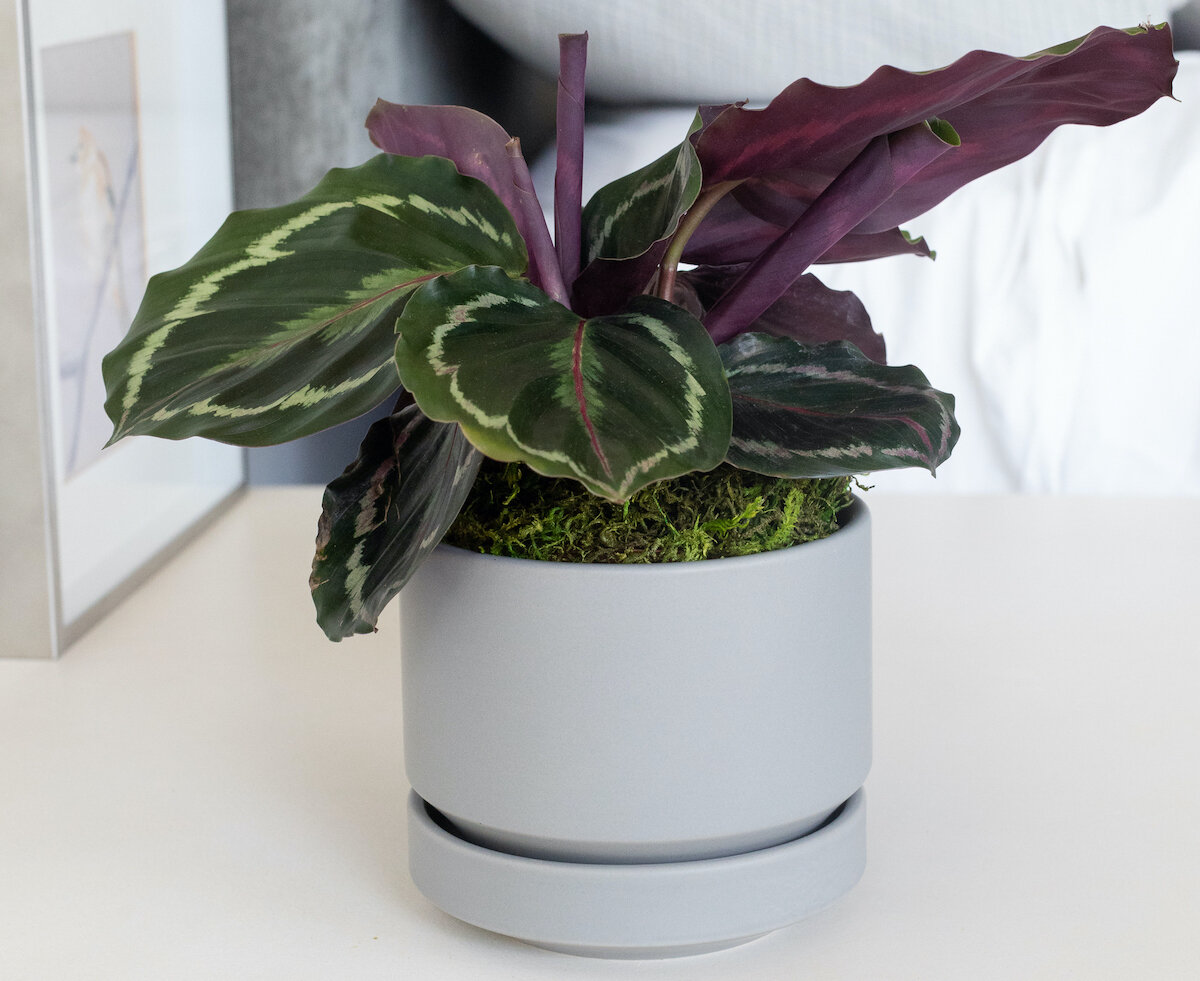
Calatheas are beloved for their stunning patterned leaves and unique nighttime folding behavior, but many plant parents struggle with one common issue: brown leaf tips and edges. If you’ve noticed your beautiful calathea developing unsightly brown spots or crispy edges, don’t panic! This comprehensive guide will help you understand why this happens and how to fix it.
- Botanical Name: Goeppertia spp. (formerly Calathea spp.)
- Family: Marantaceae
- Genus: Goeppertia
- Common Name: Calathea, Prayer Plant (commonly, but technically refers to related Maranta)
- Plant Type: Evergreen perennial, ornamental foliage plant
- Plant Size: Typically 1 to 3 feet tall (30 to 90 cm), and 1 to 2 feet wide (30 to 60 cm) depending on the species
Why Your Calathea Leaves Are Browning
Reason No.1 -Low Humidity
Calatheas are tropical plants that thrive in high humidity environments (60-70% or higher). Indoor air, especially during winter months, often sits around 30-40% humidity, which is far too low for these humidity-loving plants.
Signs of low humidity:
- Brown, crispy leaf edges
- Curling leaves
- Slower growth
Solutions:
- Use a humidifier near your plant
- Place on a pebble tray filled with water
- Group plants together to create a microclimate
- Consider moving to a naturally humid room like a bathroom
Reason No. 2. Water Quality Issues

Calatheas are extremely sensitive to chemicals commonly found in tap water, including:
- Chlorine
- Fluoride
- Dissolved minerals (hard water)
Solutions:
- Use distilled, filtered, or rainwater
- Let tap water sit overnight to allow chlorine to evaporate
- Consider installing a water filter
Reason No.3. Inconsistent Watering
Both overwatering and underwatering can cause leaf browning, but the symptoms appear differently:
Overwatering signs:
- Yellow leaves that turn brown
- Musty soil smell
- Root rot
Underwatering signs:
- Brown, crispy edges starting from the tips
- Wilting despite moist soil (due to damaged roots)
Reason No.4. Direct Sunlight Exposure
Calatheas prefer bright, indirect light. Direct sunlight can scorch their delicate leaves, causing:
- Brown patches on leaves
- Faded or bleached coloring
- Crispy, dry texture
Calathea Growing Requirements-

Humidity: 60-70%
- Invest in a quality humidifier
- Monitor with a hygrometer
- Mist around (not on) the plant
Watering: Consistent Moisture
- Water when top inch of soil feels dry
- Use filtered or distilled water
- Ensure proper drainage
Light: Bright, Indirect
- East or north-facing windows are ideal
- Avoid direct afternoon sun
- Consider grow lights if natural light is insufficient
Temperature: 65-80°F (18-27°C)
- Avoid cold drafts and heating vents
- Maintain consistent temperatures
- Higher humidity helps with temperature fluctuations
What To Do When Leaf Turn Brown?

When you notice browning:
1-Immediate Assessment
- Check soil moisture
- Measure humidity levels
- Examine water quality
2-Damage Control
- Trim brown edges with clean, sharp scissors
- Cut following the natural leaf shape
- Remove entirely brown leaves at the base
3-Environment Adjustment
- Increase humidity immediately
- Switch to filtered water
- Relocate away from direct light
4-Recovery Monitoring
- New growth should be healthy
- Brown edges won’t heal, but spread should stop
- Be patient – recovery takes time
🌱 Prevention is Key

Weekly Maintenance–
- Check soil moisture
- Monitor humidity levels
- Inspect for early signs of stress
- Rotate plant for even growth
Monthly Tasks–
- Clean leaves with damp cloth
- Check for pests
- Assess if repotting is needed
- Trim any damaged foliage
Bonus Tips-
- Consistency is crucial – Calatheas hate sudden changes
- Quality water matters more than frequency – Better to water less often with good water than frequently with poor water
- Watch the leaves – They’ll tell you what’s wrong before it becomes severe
- Be patient – These plants can be dramatic but are very rewarding when happy
Common Mistakes to Avoid
- Using tap water without treatment
- Placing near heating/cooling vents
- Letting humidity drop below 50%
- Overwatering in winter when growth slows
- Moving the plant frequently
Remember, some browning on calatheas is completely normal, especially on older leaves. The key is preventing it from spreading to new growth by maintaining optimal care conditions. With the right environment, your calathea will reward you with stunning, healthy foliage that showcases its natural beauty.
Your calathea’s brown leaves are simply its way of communicating its needs. By addressing humidity, water quality, and lighting conditions, you can help your plant thrive and prevent future browning issues. Happy Gardening…






